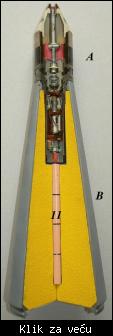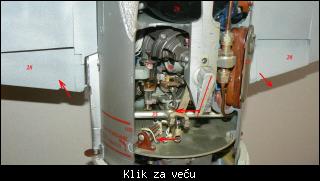offline

- Gavrilo Milentijević
- Komandir stanice milicije Gornje Polje
- Pridružio: 12 Feb 2005
- Poruke: 35626
- Gde živiš: ovalni kabinet
|
Presek prve serijske rakete V-V sovjetske proizvodnje K5 (AA-1 Alkali) sa detaljnim objašnjenjima po sklopovima....

  
  
  
 
 
Citat:Cutaway model of a Russian K5 or RS-2 US (Nato name : AA-1 Alkali) air to air guided missile. The missile is meant to destroy enemy bomber by means of blast and shrapnell of the exploding warhead.
The development of the K5 started in 1951 at research institute NII-17, by D.L. Tomasevic. The goal was to develop an air to air missile which was guided to the target by the launching aircraft by means of a tracking radar beam. In 1953, after a succesfull experimental stage, the missile was officially taken in use by the Sowjet airforce.
The AA-1 was used by the Mig-17 (4 pcs), the Mig-19 (4 pcs), the Mig-21 PF (2 pcs), the Mig-21M (4pcs) and the SU-9 (4pcs). These planes had to be modified by installing the Emerald -2 search and tracking radar in the nose of the plane. Later types of this missile also had an infra red receiver so the missile was guided to the target by means of an infra red guidance beam.
A ground radar searches the target and leads the plane to a position approximately ten kilometres behind the enemy bomber. Here the search radar of the plane takes over to find the enemy bomber and locks the bomber in it’s tracking radar beam. The missile is fired and will now try to follow the centerline of the tracking beam send by the plane to the target, at the same moment passing steering correction signals into the antenna in the tail of the missile. A major disadvantage of this so called “beam riding” guidance system is that the tracking beam fans out when the distance becomes larger, deminishing the aiming precission when the distance to the target becomes larger.
This meant the missile was best suitable for attacking straight flying targets from a behind position, but not for dogfighting as the pilot had to keep the green dot (target) in the center of his round radar screen untill the missile had reached it’s target.
The missile is build up of the following main parts:
A- The radio proximity fuze RW-2 US
B- The warhead
C- The steering fins with the actuators and servo’s
D- The PRD-45 engine
E- The compressed air vessel and battery space
F- The wings
G- The roll stabilisation mechanism and gyroscope
H- The steering electronics
J – The antenna
1- The RW-2 US fuze (A);
The RW-2 US is a radio proximity fuze which also houses the transport and firing safety mechanism.
In the nosepiece of the fuze a high frequency transmitter is placed that send out radio waves. A receiver for these radio waves is also placed in the nose of the fuze. If the signal send out is received again (bounced back from the target) the fuze will function. The fuze is sensitive enough to function when passing along the hull of a IL-26 at 13 meters distance with a speed of between 150 and 900 mtrs/sec.
Upon firing the missile, a plug (not in picture) placed in the nose end (2) of the tube in the fuze will be pulled away enabeling the airflow to serve the turbinewheel (3) of the electric generator (4). This will electrical activate the fuze enabeling it to switch from safe to armed position.
In the lower part of the fuze a spring loaded arming slider (5) which houses the electric firing cap is placed, out of line with the detonator. The arming slider is kept in this position by a ball (6) which –on it’s turn- is kept in position by a piston (7,green). Above this pistion a electric ignited (yellow) black powder (8) pellet is placed. When this pellet is ignited, the piston moves down, enabeling the ball to move away and the arming slider to move the firing cap above the detonator. The fuze is now fully armed. If the target is detected, the firing cap is activated, exploding the missile’s warhead.
When the air has passed the turbine (3), it leaves the fuze through a series of radial holes on the side of the fuze housing.
After firing the missile the ignition capacitator starts loading. The first 3.4 seconds it has not enough power to ignite the fuze (firing safety), however after 13 to 26 seconds it will unload and so explode the warhead (self destruct). This means the window in which the fuze functions starts at 3.4 seconds after launch and ends at appr 13 seconds.
The total length of the fuze is 333mm, the diameter is 76 mm. 180,4mm of the fuze protrudes from the missile’s warhead. Weight of the fuze is 2,2 kg.
2- The warhead SRI-6 (B);
The warhead exists of a conical shaped steel bushing, in which radial prefragmentation is machined. In the base of the warhead, a base flange is screwed. The upper part of the cone is internally threaded to receive a steel bushing in which the fuze RW-2 US is placed. Below this bushing a booster charge, existing of four stacked cylinders (11) of high grade explosives is placed in the main charge of 6,3 kg TNT / Hexogeen 60/40%.
If the warhead explodes, it will deliver appr. 828 fragments with a weight of between 3 and 7 grams which travel with a speed of between 1600 and 2400 mtrs/sec. Due to the shape of the warhead, the fragments are thrown forward with an angel of 15 degrees from the centerline of the missile.
3-The steering fins and steering fin actuators (C);
The steering fins (12) steer the missile to it’s intended target. The fins exist of two pairs of –opposite placed- fins, placed on one shaft (13). The shaft is connected to an air served double cylinder actuator (15) by means of an angled arm (14). These cylinders are placed in a triangular housing (16) of which one point forms the pivot point (17) and the upper part is drilled out on two sides to form two opposite holes (cylinders) , rotating up and down over two fixed pistons (19) . On top of the triangular housing –between the cylinders- a hinge point (18) is placed to which the arm (14) is connected.
By pressing air into one of both cylinders (15) the cylinder block will rotate, the arm will move up or down, rotating the shaft (13) with the fins (12).
Below this steering unit an airdriven gyroscope (20) is placed that also serves as a dynamo. It is however not clear to me what the main goal is; gyroscope either dynamo. The pressurized air for serving this gyroscope is derived from the pressurized air vessel (E).
4- The PRD-45 engine (D);
The engine exists of a cast barrel with a screwed in top flange. two opposite placed venturi’s (21) are screwed in the base, placed in a slightly outward angle. A grid (22) is screwed to the base of the barrel inside to prevent burning pieces that break from the fuel stick (23) from blocking one or both venturi’s. The fuel stick is cylinder shaped with an appr. 25mm dia. hole in the center. Above the fuel stick an aluminium ring shaped container (24) housing the ignition charge is placed. On the inside of the barrel twelve longitudal 2,5mm thick woodstrips are placed, devided over the circumference. These strips enshure the flame of the ignition charge ignites the outside of the fuel stick as well as the hole through the stick, enshuring a fast and even burning up of the fuel stick.
Placing the engine in the middle of the missile was a new concept, however one of the big advantages one found was that the center of gravity did not move after the burning up of the fuelstick in the motor, making steering of the missile easier.
5- The Battery and pressurised air space (E):
In this space the Battery (25) and the -150 bar- pressurized air vessel (26) is placed. The battery is used to serve the steering electronics (H) in the tail, the pressurised air serves the steering fins and the gyroscopes. I suppose the battery deliveres DC current for the electronics , while the gyroscope /generators deliver AC current for the rest of the instruments. This last however is a suspicion.
The data link plug (27) with the aircraft and the test circuit plugs are also placed in this space.
6- The wings (F);
The wings enshure stabilisation during flight. The rudders (28) of the roll stabilisation mechanism are placed in the wing roots. On the four wingtips a threaded hole is placed in which the flare PS-253 M5 can be screwed for visual observation of the missile’s path. If the flares are not used, a drop shaped aluminium dummy (29) is placed (as on picture).
7- Roll stabilisation mechanism (G);
The roll stabilisation mechanism enshures the missile does not roll either clock- either counterclockwise. The mechanism is build up of a air driven gyroscope (30, which serves a measuring valve (31) that actuates an air served double cylinder. These cylinders are placed in a triangular housing (32) of which one point forms the pivot point (33) and the upper part is drilled out on two sides to form two opposite holes (cylinders) , rotating up and down over two fixed pistons (36) . On top of the triangular housing –between the cylinders- a hinge point (34) is placed which is connected to the cross and rotates it left or right when one of the cillinders is pressed full of air.
The air driven gyroscope (30) also has a build in dynamo (38) of which the purpose it not really clear to me.
The missile’s wings are positioned in a x configuration when hanging on the pylon under the wing, however the angle and one fixed shaft (no gimbal) of this gyroscope give away that after leaving the rail on the underwing pylon the missile’s wings will take a + position.
8- The steering Electronics (H) and the antenna (J)
The steering electronics (H) is placed in the tail of the missile. Here the signal , received by the antenna (J) from the tracking radar is translated to cource adjustment signals to the air served double cylinder blocks of the steering fins. It will steer the missile to the centerline of the tracking radar beam, aimed at the target.
Data AA-1 Alkali:
- Length : 2500 mm (8ft 2”)
- Diameter : 180mm (7,1”)
- Wingspan : 654mm (2ft 2”)
- Weight complete missile : 83,2 kg (183,4 lb)
- Weight warhead : 15,2 kg (33,5 lb)
- Weight explosive charge : 6,3 kg Trotyl / Hexogeen (60/40)
- Burning time engine : 5,5 seconden
- Vo: 2320 km/h (644 mtrs/sec)
- Minimal range : 2 km (1,25 miles)
- Maximum range : 6 km (3,75 miles)
- Minimal altitude : 700 meter
- Maximum altitude 16.600 mtr
- Guidance method : beam rider
|

